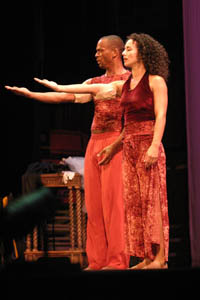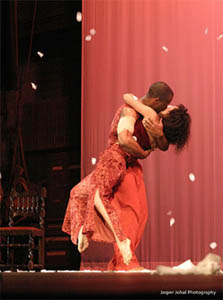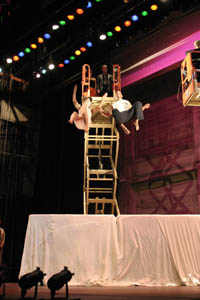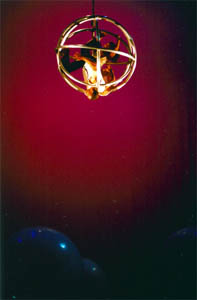A dance performance and wedding ceremony
Choreographed and performed by Nehara Kalev and C. Derrick Jones
Rachel Rosenthal, officiant; with members of the Kalev and Jones family
Music by Ry Welch
June 19, 2004 – Wilshire Ebell Theater, Los Angeles
Composing the music for a wedding was an opportunity to work in a context charged emotionally, psychologically and socially
by its nature. When I was approached by Derrick and Nehara about doing some music for their new production, I was quick to
decide that not only would I compose some of the music, but would compose all of it. I knew that a hodge-podge of music from
various sources would fragment the performance and diminish its impact; as the sole composer, I could insure that the
continuity of the program was kept intact and that all the various dramatic elements were addressed within a singular context.
Being the sole composer also allowed me the opportunity to create relationships throughout the work that would contribute to
the relaying of Derrick and Nehara’s vision.
Music and dance are primal to human beings, and have an important place within the rituals of every culture. In our time and in
our culture, rituals have become compartmentalized. The current standard for most rituals tends to be pomp, circumstance and a
stiff upper-lip followed by a relax and let-loose party. The music and dance that once had its place in the ceremony has been
toned down, and in most cases banished to the “after” celebration. With a wedding this is most recognizable, as at the reception
some of the most significant aspects of the ritual take place (the bride’s last dance with her father, the couples first dance). “The
Wedding Journey” concept was to reinstate some of the elements that the contemporary wedding ceremony was lacking- most
importantly, the powerful combination of music and dance, and their ability to communicate the fundamental concepts of
marriage. My goal in composing the music for “The Wedding Journey” was to facilitate in the communication of these concepts.
The Prelude occurs before any action on the stage. I approached this opening to the ceremony in a traditional way, by making
a grand yet simple statement. The desired effect, at the most basic level, was to let everyone know that the ceremony is
beginning. Since the typical wedding opens with the sound of the organ, I chose to feature the organ in this piece. As a culture
we have a trained response to the organ, as it is usually associated with weddings, funerals, and other sacred rituals, and this
response was what was necessary to transform a theater – a secular space – into a sacred space. Sanctifying a space through
sound is one of the most vital parts of any ritual, and the Prelude serves this function.
The opening figure in the violins, circling and repeating, introduces the major theme of Derrick and Nehara’s production: the
circle- the circle of life portrayed in the movements of dance, and embodied in the wedding ring. The circle is a symbol
associated with wholeness and eternity. In the final piece, “Knot”, this repeating string figure returns as a reminder of this
powerful theme.
The music for the opening monologue was constructed to serve as a simple backdrop that would set a mood and leave plenty of
room for the officiant of the ceremony, who on stage delivers an improvised text. The music shifts subtly throughout, adding
inflection and emphasizing a dramatic arc.

“Are You Sleeping?” was a piece that Nehara and Derrick had performed several
times in the past and wanted to incorporate into “The Wedding Journey”. Working
with a video of one of the past performances, I scored music to their movements
highlighting the various sections and actions of the piece. “Are You Sleeping?”
takes place within a dream-world, where subconscious elements bubble up to the
surface and then melt down into the continuously ebbing ocean of the mind. The
question I asked was “who is the dreamer? Is it Derrick? Is it Nehara?” The best
answer, and the answer that determined my approach to the music, is that the
dream portrayed is being dreamed by both concurrently, consisting of archetypal
forms residing in the collective unconscious. My goal with the music was not
merely to portray the common unconscious realm of two people, but to tap into the
collective unconscious as a whole- so that the dream shared by Nehara and Derrick
on the stage becomes a collective dream shared by everyone in the theater. In
working to achieve this in a methodical way, as through meditation, each musical
section dives progressively deeper into the psyche along with the forms portrayed
on the stage.
The theme of this segment is the individual family histories of Derrick and Nehara,
and how these histories are a continuing story of which they are a part. Since both
have significant family history in New York City, with “Legacy” I wanted to bring
the feeling of the New York City streets into the theater. This piece is put together
like an Impressionist painting, as I employed many small, broken elements in the
execution of a singular idea: to create a specific mood that is greater than the sum
of it’s parts. In this sense, the music served as a reflection of Derrick and Nehara’s
continuing history, composed of elements that create a story greater than the sum
of its parts.
For “Conflict”, Nehara and Derrick’s concept was to have a very melodic piece of
music that at times they would move with and at other times against.. Since the
action was to be the couple dancing together harmoniously, then conflict between
them arises and subsides, and so on, I took what I considered the most obvious
route and composed a waltz. Just as the organ of the “Prelude” has specific
connotations, the feeling of a waltz has it’s own connotations and generally elicits
a predictable emotional response. In the setting of a wedding ceremony, where so
much emotion is in play, I found it essential to use various concrete elements (like
the organ or the waltz) to anchor those emotions and offer points of collective
stability as the program progressed.

This segment of the performance portrays, in a light-hearted context, the romantic
tension between man and woman. For “Table”, Nehara and Derrick asked for a fun
piece of Klezmer music. I began working on the music while they were still in the
process of choreographing the piece, and serendipitously, when they gave me a
rehearsal video it fit perfectly with the music I had thus completed (about the first
half). I then went on to score the remainder of the music to the rehearsal video. I
took full advantage of my jazz background when composing this piece, ensuring
that the music had as much energy and life as the performers on stage.
When Nehara and Derrick described the petals that would be falling slowly and
continuously from above the stage during this piece, I had a clear vision of the
music. I imagined the rhythm of the falling petals (portrayed by the ostinato flutes)
and the slow, intertwining movements of the dancers (portrayed by the strings),
and constructed a flowing piece of music that I would liken to a softly running
river: more intense in some areas, less in others, and continuously moving without
beginning or end- as is the love the couple were looking to embody in this
segment of the performance.

As with the “Monologue A (Amore)” segment, this music was a backdrop for
improvised text, but this time featuring six members of the couple’s family. I was
instructed to create a piece with six main sections, each sixty seconds in length,
plus a short introduction and a sizeable closing section in case some (or all) of the
speakers exceeded their time allotment. As also instructed, at approximately forty-
five seconds into each of the six main sections there is a sonic cue to let the speaker
know that time is almost up. Unaware of what any of the six family members would
say, I felt it best to leave as much room as possible and employ subtle shifts in
style and timbre from speaker to speaker, in complete awareness of the individuality
of each and a necessity to accentuate that individuality; as each speaker is
different, with different things to say and ways of saying it, so are each of the six
main sections. A different instrument is featured in each of the six main sections; in
the long closing section, all of the instruments used in various combinations
throughout the piece come together to reflect the two families joining together
through the marriage of the couple.
This music is also a background for an improvised text. As this segment is the precursor to the wedding vows, I again
employed the organ as a psychological cue. For this music, I wanted to create a subtle tension to heighten expectations. As
simply and clearly as possible I set out to construct music that emphasizes the drama of the moment and the drama of the text
being presented. Knowing that this would be the last music heard until after vows were exchanged and the couple joined, I
wanted to create a feeling of suspension that carried over after the piece ended and sustained until the next piece of music
began. To achieve this I used repetitive, unresolving figures over an extended period. The ending of this piece is only partial
and leaves the listener feeling unsatisfied until the next piece of music begins and tension is at last resolved.
After the couple has been married, standing on a platform twenty feet above the
stage, they jump together and land on a crash pad dressed as a giant bed. For the
moment of impact (and continuing for four minutes or so thereafter) Nehara and
Derrick requested a big celebratory pop song with a retro R&B feel. Since this was
to be the only “song” composed for the program, I saved working on it until all of
the other pieces had been completed. This was the most significant moment in the
performance, and I wanted to harness all the emotion from the work I had been
doing and let the joy of completing the project manifest itself fully in this piece of
music.
Subsequent to writing the main riff , I was fortunate to have the chorus lyric pop
into my head. Working from that I constructed the verse lyrics and finally the
bridge lyrics. As is typical with this type of song, the music for the chorus and
verse sections are virtually the same. For the bridge I decided on a standard R&B
bridge progression; anything “fancy”, I discovered, would be disruptive to the
flow (with a dance/ party song, flow is of utmost importance). The real challenge of
this piece was that it not be challenging- every note and every word should sound
easy and natural, and every moment should be a fulfillment of expectations. Unlike
the music for the previous segment, this music must have as little tension as
possible, as it marks the resolution of the entire performance.


“Knot” is the coda to the performance. The dancers are together inside a large ball
constructed from aluminum rings that hangs above the stage, spinning. The theme
of the circle, ring and eternity is restated a final time. For the music, which Nehara
and Derrick wanted as a Drum’n’Bass track with Middle Eastern flavors, I use the
initial thematic material from the prelude as the foundation- showing that we have
now come full circle in the program. This string figure repeats continuously and
unchanged throughout the piece, emphasizing the eternal circle.
Ry Welch - July 7, 2004